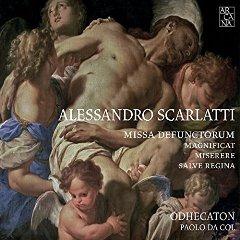Alessandro Scarlatti - Missa defunctorum, Magnificat, Miserere & Salve Regina (2016)
Alessandro Scarlatti - Missa defunctorum, Magnificat, Miserere & Salve Regina (2016)

1. Missa defunctorum: Introitus - 5:01 2. Missa defunctorum: Kyrie - 1:36 3. Missa defunctorum: Graduale - 3:43 4. Missa defunctorum: Sequentia (Dies irae) - 5:36 5. Missa defunctorum: Sequentia (Lacrimosa) - 3:34 6. Missa defunctorum: Offertorium - 6:18 7. Missa defunctorum: Sanctus - 3:30 8. Missa defunctorum: Agnus Dei - 3:06 9. Missa defunctorum: Communio - 3:13 10. Salve Regina - 9:16 Alessandro Carmignani – counter-tenor Andrea Arrivabene - counter-tenor, alto Vincenzo Di Donato - tenor Enrico Bava - bass 11. Miserere - 9:37 12. Magnificat: Magnificat - 2:42 13. Magnificat: Quia respexit - 1:25 14. Magnificat: Quia fecit - 2:13 15. Magnificat: Fecit potentiam - 1:40 16. Magnificat: Deposuit potentes - 2:03 17. Magnificat: Esurientes implevit bonis - 5:34 18. Magnificat: Sicut locutus est - 0:49 19. Magnificat: Gloria patri - 5:27 Alena Dantcheva - soprano Jennifer Schittino - soprano Alberto Allegrezza - tenor Gianluca Ferrarini - tenor Odhecaton Paolo Da Col – conductor
These four sacred works by Alessandro Scarlatti display stylistic traits which, on the one hand, are derived from those of Palestrina and, on the other hand, show a particular attention to advanced expressive techniques. Although they are conservative in their scoring, being either a cappella or for voices with continuo, Scarlatti augments that basic texture with more heterogenous styles, especially in the Missa defunctorum and the Magnificat setting. --- areditions.com
This recording is a discovery of Alessandro Scarlattis heretofore unknown sacred music, where Renaissance tradition meets Baroque sensibility for a unique and compelling recording. At the core of Odhecatons latest offering is the Missa defunctorum for four voices and basso continuo. It is in this magnificent score recorded for the first time using the critical edition of Luca Della Libera that primarily contrapuntal writing gives way to Scarlattis stylistic choices of great expressivity and rhetorical force, such as in the case of the astonishing Lacrimosa. The Miserere is also recorded for the first time. Written for nine voices for the Sistine Chapel, the score follows Allegris model only outwardly; Scarlatti, in fact, moves steadily away from it through his harmonic originality, formal richness, and expressivity. The Magnificat displays a unique synthesis of the Palestrinian model and the expressive language of the eighteenth century. In this score, Scarlatti exploits the great wealth and variety of the Marian text, particularly in the relationship between words and the emotional and descriptive spheres. ---amazon.com
download (mp3 @320 kbs):
yandex 4shared mega mediafire cloudmailru uplea ge.tt








